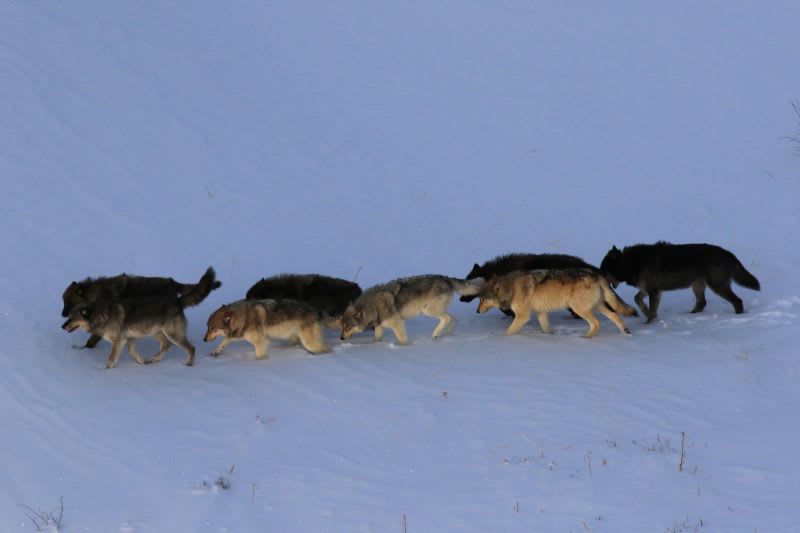دبي، الإمارات العربية المتحدة (CNN)-- تعيش الذئاب في مجموعات تقودها أنثى وشريكها. وتبقى بعض الذئاب مع القطيع الخاص بها طوال حياتها، وتساعد في الصيد، وتربية الجراء أثناء نشأتها، ولكن ينفصل البعض الآخر للعثور على رفيق خاص به، وبدء قطيعه الخاص.
وهناك الكثير من العوامل التي تؤدي لهذا النوع من السلوك، مثل السمات الشخصية، والعلاقات الأسرية التي تنشأ منذ الصغر، ولكن كشفت النتائج العلمية الجديدة عن جانبٍ مفاجئ يؤثر على ديناميكيات قطعان الذئاب، وهو طفيلي يسيطر على العقل، ويجعل الذئب الرمادي ينخرط بسلوكيات أكثر خطورة.
ووجد الباحثون أن الذئاب الرمادية في متنزه "يلوستون الوطني" المصابة بطفيلي يُعرف باسم "توكسوبلازما جوندي (Toxoplasma gondii) كانت أكثر عرضة لترك القطيع الذي ولدت فيه.

ويمكن أن تؤدي هذه الاكتشافات المذهلة إلى تغيير فهم العلماء لديناميكيات قطعان الذئاب، وتحسين جهود الحفاظ على حيوان مفترس مهيمن يؤدي دورًا رئيسيًا في صحة نظامه البيئي الجبلي.
السلوك المحفوف بالمخاطر للحيوانات المصابة

وراقب العلماء الذئاب في متنزه "يلوستون" الوطني منذ إعادة إدخال هذه الكائنات إلى المنطقة في عام 1995.
وتتم مراقبة سلوك القطعان عبر كاميرات موضوعة عند المسارات، وجولات بالطائرات، كما ترتدي ربع الذئاب تقريبًا أطواق تتبع لاسلكية، وتخضع لاختبارات الدم.
وكشفت هذه الاختبارات أن بعض الذئاب مصابة بـ"T. Gondii"، وقد يكون ذلك نتيجة مشاركة الموائل مع حيوانات الـ"كوجر" على الأرجح.
ولفت وجود "T. gondii" انتباه الباحثين، بما في ذلك المؤلف المشارك الرئيسي للدراسة، وطالب الدكتوراه بمختبر "Ungulate Ecology Lab" بجامعة "مونتانا"، كونور ماير.
ونظرًا لتأثير الطفيلي على ميل الحيوان للمخاطرة، قال ماير إنه قرر مع زملائه التركيز على الذئاب التي تتصرف بجرأة، وسألوا أنفسهم: "ما السلوكيات التي يمكننا قياسها؟ وهل قمنا بقياسها على مدى 25 عامًا؟ ثم ما هي السلوكيات التي نعتقد أنه يمكن اعتبارها محفوفة بالمخاطر؟".
ويُعرّض الذئب نفسه للخطر عندما يترك عائلته، ويذهب للانضمام، أو تكوين مجموعة جديدة، ولذلك نظر الباحثون إلى الوراء في سجلات توزيع الذئاب، وقيادة القطيع على مدار ربع قرن، والمرتبطة بنتائج اختبارات الدم من جميع الذئاب في الدراسة.
ووجد فريق الدراسة شيئًا مذهلاً، إذ قالت عالمة الأحياء البرية، والباحثة المشاركة في مشروع "ذئاب يلوستون"، والمؤلفة الرئيسية المشاركة الدراسة، كيرا كاسيدي: "الذئب الذي يُظهر نتيجة إيجابية لتوكسو أكثر عرضة لترك الفريق بـ 11 مرة مقارنةً بالذئب الذي يُظهر نتيجة سلبية"، وأضافت: "وبعد ذلك كان التحوّل لقائد قطيع تأثيرًا أكبر، فالذئب الذي يُظهر نتيجة إيجابية كان من المرجّح أن يصبح قائدًا للقطيع من الذئب الذي يُظهر نتيجة سلبية بـ 46 مرة".
توزيع الذئاب والحفاظ عليها
وبالنظر إلى الأنماط السلوكية المرتبطة بـ"T. gondii" لدى الحيوانات الأخرى، يشتبه الباحثون بأن المرض مسؤول عن هذه التوجهات.
وذكرت عالمة البيئة السلوكية في جامعة "ستوكهولم"، كريستينا هانسن ويت، أنها متحمسة لرؤية المزيد من الاستكشافات من فريق البحث.
وقالت هانسن ويت التي لم تشارك في الدراسة: "أمر واحد سأكون مهتمًة به حقًا هو كيفية تأثير هذا الطفيلي على السلوكيات الأخرى؟".
وأشارت هانسن ويت إلى أن الجرأة قد تفسّر ترك الذئب لقطيعه، ولكنها تساءلت عمّا إذا كانت للسلوكيات الأخرى، بما في ذلك العدوانية، أي حضور عند تعامل الذئب مع أفراد قطيعه، ما قد يؤدي إلى طردهم بشكلٍ فعال.
وأكّدت هانسن ويت أن فهم كيفية توزّع الذئاب وتفاعلها مع بعضها البعض، سواء بمفردها، أو تحت تأثير الطفيليات التي تتحكم في العقل، يمكن أن يساعدنا في تلبية احتياجاتها بشكل أفضل، وشرحت: "كلما تعلمنا المزيد عن سلوك الذئب، كلما كان بإمكاننا فهم كيفية الحفاظ على هذه الأنواع بشكلٍ أفضل".







